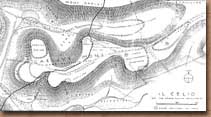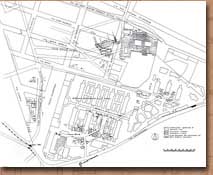The pre-existing archeological structures
edited by Raffaele Pugliese
The cloister is situated in a particularly important sector from a topographical and archeological point of view on the Coelian Hill; more precisely, on its flattened summit where it finds itself at the point of convergence of several former arterial Roman roads of the Imperial age (fig. 1). It is probable that the buildings lining these axes, perhaps insulae, that is houses to rent or commercial structures, may have been partially used as substructures for the construction of the cloister, a hypothesis that could be further supported by closer archeological studies in loco (fig.2).
This urban fabric was profoundly altered at the beginning of the 4th. century A. D. with the construction of a vast domus, or of a noble residence of high level. Of this residence, there remains a vast hall with an apse at one end rising up like a tower at today's crossroads between Via dei Querceti and Via dei Ss. Quattro. Inside the hall, probably between the end of the 5th. century A.D. and the beginning of the next, the ancient Paleo-Christian titulus was established and subsequently the Carolingian church in the 9th. century.
This noble domus was to extend over a vast tract also towards the south, a flat and panoramic area, which would then be occupied by the medieval cloister. At this strategic point and some distance from the Via Tuscolana, an important arterial road in ancient Rome (today Via dei Ss. Quattro Coronati), positioned to the north and along which it would be plausible to find the entrances and domestic areas, the remains of the residential wing are probably buried. This was the most opulent part of the residence with reception rooms for close friends, triclinia and above all a portico leading into peristyles and gardens, areas that were usually embellished with sculptural decorations and precious marble pavements. Traces of it may come from the remains of a porticoed structure of late Imperial age discovered a few years ago behind the chapel of Santa Barbara and which seemed to proceed towards the cloister area.
|
© 1999 Coordination
Monica Morbidelli |
|
Fig. 1 - "The Coelian hill in its original physical state" by A.Colini, Storia e topografia del Celio,Città del Vaticano 1944, Tav. I.
Fig. 2 - The Caput Africae and neighbouring zones in the imperial age (revised by A. Colini, Storia e topografia del Celio,Città del Vaticano 1944, Tav. XVI and C. Pavolini, Il Caput Africae, Roma 1993, Tavv. I - II). |
|
|
|
|

